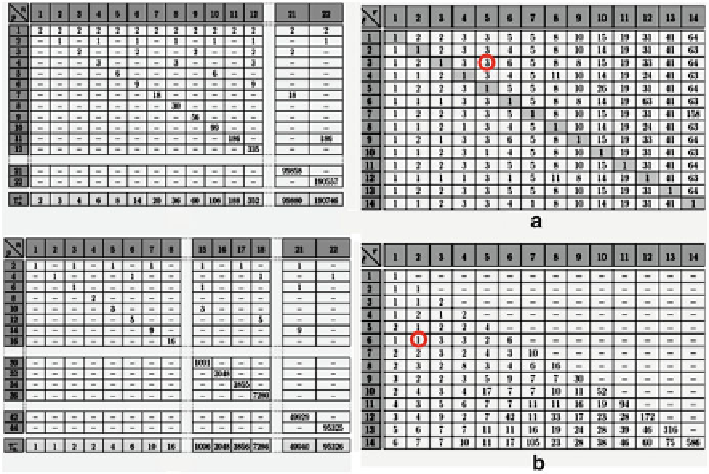Biology Reference
In-Depth Information
Fig. 4.19
Left
: Number of attractors of period
p
for positive (
top
) and negative (
bottom
) circuits of
order
n
, in case of parallel updating mode (after Demongeot et al.
2012
).
Right
: Total number of
attractors in case of tangent circuits, where (a) the left circuit of order
l
is negative and the right
circuit of order
r
is positive and (b) both side circuits are negative
of the period of the attractors (fixed configurations, if the period is 1, or limit cycles
of configurations, if the period is strictly more than 1, cf. Table
4.18
).
For example, if the common gene PU.1 of the example of the Fig.
4.16
is split
into 2 genes in order to incorporate the negative circuit of order 2 inside the
negative circuit of order 6, it would give birth to a positive circuit of order 8 having
8 attractors, and only one attractor in the case of tangency of the two negative
circuits (Table
4.18
and Fig.
4.19
). More generally, the number of observed
attractors (fixed points and cell cycles) in circuits with Boolean transitions identity
or negation can be calculated in case of parallel updating by using Tables given in
(Demongeot et al.
2012
) for the cases of isolated, tangential, or intersecting circuits,
generalizing the results of Fig.
4.16
(from Demongeot et al.
2012
). We observe a
rapid increase of the number of cell cycles, when the order of the circuits increases
in the network, corresponding in general to an increase of their evolutionary
entropy
E
. A way to diminish this number is to introduce up-stream inhibitors
like microRNAs.
A last important feature of the getBren dynamics, as we have seen in Sect.
4.4.2
,
is the existence of genes influencing directly the opening of the DNA inside the
chromatin, hence allowing or not the gene expression. If these genes are controlled
by microRNAs (Demongeot et al.
2013a
,
b
,
c
), it is necessary to generalize the
getBren structure by considering that the possibility to update a block of genes at
iteration
t
is depending on the state of
r
“clock” genes (i.e., involved in the chromatin

Search WWH ::

Custom Search